Bulldog Soccer Academy
Facilities
Reese Stadium
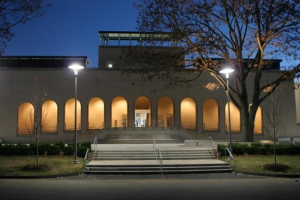 Yale’s lacrosse and soccer teams have one of the finest multi-purpose athletic venues in college sports. Formerly known as the Soccer-Lacrosse Stadium (1981-2011), it was renamed Reese Stadium in 2011.
Yale’s lacrosse and soccer teams have one of the finest multi-purpose athletic venues in college sports. Formerly known as the Soccer-Lacrosse Stadium (1981-2011), it was renamed Reese Stadium in 2011.
In addition to a Field Turf surface replete with Yale logos and surrounded by protective netting, Reese Stadium has four air-conditioned team rooms, a concessions area and a ticket office. The complex, which also includes the Kempner Family Plaza on the front side, has permanent stadium seating for 1,250, multiple sets of bleachers at field level, the 5K Corral Press Box and covered viewing/meeting areas at the top of the stadium. A video scoreboard on the Western side sits atop the line of pines that surround the facility.
Renovation of the facility was made possible through the generous leadership gifts from Jason Reese ’87, Jon Reese ’90, Jamie and Cynthia Kempner ’79, and an anonymous $1 million challenge match from another former Eli player to the Yale Soccer Association in 2008. On April 9, 2011, the home of the Yale soccer and lacrosse teams was officially dedicated and named after the Reese brothers.
Jason was a star goalie for the Bulldog lacrosse team, while Jon is the most prolific scorer in Yale lacrosse history and was the captain of an Ivy League championship football team. The Yale Lacrosse Program enjoyed its finest era (Ivy titles in 1988, 89, 90) with a Reese on its roster.
The stadium has also hosted numerous international soccer teams. It was used as the practice site for the U.S. national squad before its game against Juventus of Italy in June 1991 at Yale Bowl and by Brazil in the opening game of the 1993 U.S. Cup. In 1995, the stadium was the main soccer venue for the Special Olympics World Games.
Clint Frank Field
The home of Yale track and field since its inception as a sport in the 1870s, Dewitt Cuyler Athletic Complex and the Dwyer Track are among the premier track and field facilities in the nation. The eight lane En-tout-cas surface was laid in 1981, replacing a legendary cinder oval, the likes of which had rarely been scene. The old track had two 200-meter straightaways, enabling runners to race a one-turn 400-meter dash and a straight 200-meter dash. The new layout was resurfaced in the summer of 1995 in preparation for the Special Olympics World Games.
The creative layout of the facility allows for competition in all events including the hammer, discus and javelin within the complex. Sprint straightaways are marked to allow for competition in both directions depending on the prevailing winds, and multi-directional runways in the long and triple jumps and the pole vault allow for optimal performance. A huge high jump apron makes for a great jumping area. Three shot-put circles, two hammer/discus cages and an all-weather javelin runway make the facility a thrower's dream.
Bleachers on the sprint straightaway seat 1,500, making the complex a tremendous host site for championship meets. Dewitt Cuyler and Yale have served as hosts for three IC4A championships (most recently in the spring of 2004) and six Heptagonal Championships (most recently in 2011). In the summer of 1995, 5,000 Special Olympics Athletes from around the world competed in the Special Olympics World Games at the facility.
The infield of the track serves as Frank Field, named after Yale Heisman Trophy winner Clint Frank '38. It is a practice field for the Yale varsity football team, and hosts junior varsity football games in the fall.
Johnson Field
Johnson Field opened as the new home of Yale Field Hockey in the spring of 2001. The 750-seat synthetic turf complex sits adjacent to DeWitt Family Field, the home of Yale Softball. Stadium seating for Johnson Field is along the east side of the complex. Entrance to the bleacher stadium is up a concourse walkway behind the seats with bridge access to the bleachers from the top level preventing interference with spectators in their seats viewing a contest. A press box with camera access above sits at midfield overlooking the field. On the opposite, or west, side of the field there is a berm lined with trees where spectators can sit on the grass and watch the game.
The Astroturf field, which is royal blue, is 240' x 390' and was installed in the summer of 2013.
The field is lighted for night play with a sports lighting system capable of providing a minimum of 50 foot-candles over the entire playing field. The sport lighting system provides for glare and spill control thereby only lighting the playing field and not the surrounding areas.
Johnson Field also served as the home of Yale Women's Lacrosse from 2000 through 2008.
Coxe Cage
Coxe Cage is the home of the Yale men's and women's indoor track and field teams. In 2005, Coxe Cage underwent major renovations, installing a banked Mondo track as well as a Mondo infield. The renovations were able to take place due to the generosity of Donald M. Roberts '57, who named the track the Frank Shorter '69 Track, to honor the former Yale cross country captain and two-time Olympic medalist. The track is one of the premier venues in the United States, and provides Yale athletes with an unparalleled training and competition facility. A new digital scoreboard was installed as well.
"It's an incredible facility with a banked track that provides a much faster running surface than the flat tracks generally do at a lot of schools. It's a really nice surface. The facility itself is older-looking but it's a very natural and rustic environment to run in. The track is very fast and comparable to most tracks on the East Coast. More of the heralded tracks on the East Coast are at places such as the Armory and the Boston University track -- they are considered to be the fastest -- and I really think that this track is just as quick."
The Cage was named for Charles Edmund Coxe (1893), a hammer thrower on Yale's squad. Legend has it that Coxe, who was charged with raising funds for the new facility, could not be bothered with such efforts and instead offered the necessary $300,000 to build the facility on the stipulation that it be named for him. Yale accepted the offer and began construction on what was then considered to be one of the largest structures of its kind in the world. Measuring over 356 feet long and 156 across, with a ceiling reaching almost 83 feet, the building encompasses over 3.3 million cubic feet of air space. To this day its 26,000 square foot skylight is among the largest anywhere. At the time of the Cage's construction, its track was designed to be one of the fastest in the east. At the opening ceremony for the new facility, Yale's half-mile relay ran an exhibition in a time of 1:32.4, better than any previous indoor mark.
In 1982, Coxe Cage also underwent major renovations. The old cinder track and dirt floor were removed in favor of a state of the art, "tuned", En-tout-cas oval and infield. The track was mounted on a structure designed to allow the runner to train more consistently without suffering the strain and injury incurred on other surfaces. At the time of its installation it was thought to be the most advanced track of its kind. In 1988, another track was installed.
All field events can be contested within the oval, including the shot put and weight throw.
Coxe Cage and the William Clay Ford Indoor Track Center have played host to many major championship meets, including multiple ECAC championships and national scholastic championships.
CFC Arena
The CFC Arena is New Haven County’s premier indoor center. We provide a family atmosphere that has the ability to cater multiple sports and events. The CFC arena currently has two 65×35 yd. non boarded fields and one 35×15 yd. training area. Unlike many indoor soccer fields, the 2 65x35yd non boarded fields use 7x21ft goals to help replicate the outdoor game. No outdoor cleats allowed!
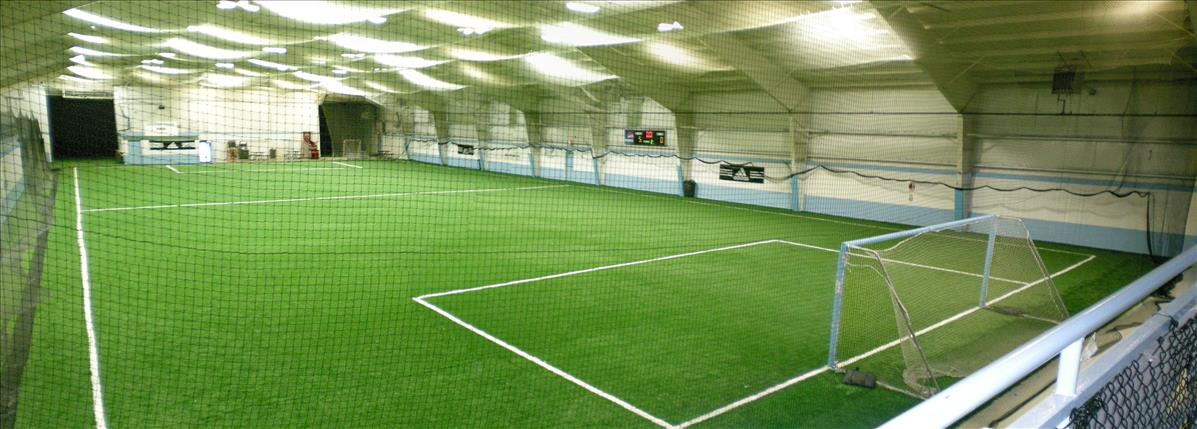
|
|
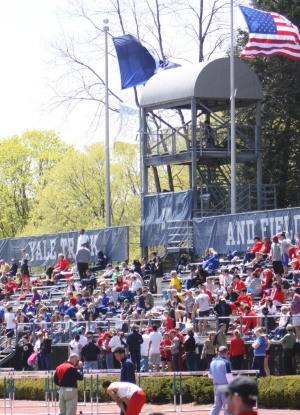 The home of Yale track and field since its inception as a sport in the 1870s, Dewitt Cuyler Athletic Complex and the Dwyer Track are among the premier track and field facilities in the nation. The eight lane En-tout-cas surface was laid in 1981, replacing a legendary cinder oval, the likes of which had rarely been scene. The old track had two 200-meter straightaways, enabling runners to race a one-turn 400-meter dash and a straight 200-meter dash. The new layout was resurfaced in the summer of 1995 in preparation for the Special Olympics World Games.
The home of Yale track and field since its inception as a sport in the 1870s, Dewitt Cuyler Athletic Complex and the Dwyer Track are among the premier track and field facilities in the nation. The eight lane En-tout-cas surface was laid in 1981, replacing a legendary cinder oval, the likes of which had rarely been scene. The old track had two 200-meter straightaways, enabling runners to race a one-turn 400-meter dash and a straight 200-meter dash. The new layout was resurfaced in the summer of 1995 in preparation for the Special Olympics World Games.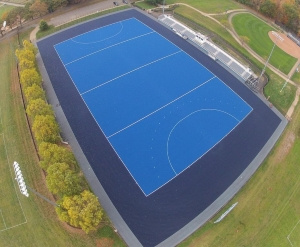 Johnson Field opened as the new home of Yale Field Hockey in the spring of 2001. The 750-seat synthetic turf complex sits adjacent to DeWitt Family Field, the home of Yale Softball. Stadium seating for Johnson Field is along the east side of the complex. Entrance to the bleacher stadium is up a concourse walkway behind the seats with bridge access to the bleachers from the top level preventing interference with spectators in their seats viewing a contest. A press box with camera access above sits at midfield overlooking the field. On the opposite, or west, side of the field there is a berm lined with trees where spectators can sit on the grass and watch the game.
Johnson Field opened as the new home of Yale Field Hockey in the spring of 2001. The 750-seat synthetic turf complex sits adjacent to DeWitt Family Field, the home of Yale Softball. Stadium seating for Johnson Field is along the east side of the complex. Entrance to the bleacher stadium is up a concourse walkway behind the seats with bridge access to the bleachers from the top level preventing interference with spectators in their seats viewing a contest. A press box with camera access above sits at midfield overlooking the field. On the opposite, or west, side of the field there is a berm lined with trees where spectators can sit on the grass and watch the game.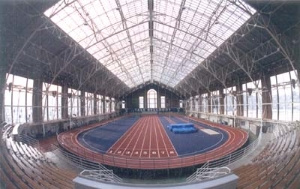 Coxe Cage is the home of the Yale men's and women's indoor track and field teams. In 2005, Coxe Cage underwent major renovations, installing a banked Mondo track as well as a Mondo infield. The renovations were able to take place due to the generosity of Donald M. Roberts '57, who named the track the Frank Shorter '69 Track, to honor the former Yale cross country captain and two-time Olympic medalist. The track is one of the premier venues in the United States, and provides Yale athletes with an unparalleled training and competition facility. A new digital scoreboard was installed as well.
Coxe Cage is the home of the Yale men's and women's indoor track and field teams. In 2005, Coxe Cage underwent major renovations, installing a banked Mondo track as well as a Mondo infield. The renovations were able to take place due to the generosity of Donald M. Roberts '57, who named the track the Frank Shorter '69 Track, to honor the former Yale cross country captain and two-time Olympic medalist. The track is one of the premier venues in the United States, and provides Yale athletes with an unparalleled training and competition facility. A new digital scoreboard was installed as well.